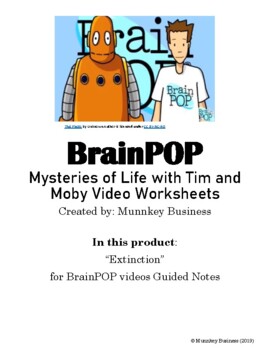"Extinction" for BrainPOP video - Distance Learning
- PDF
- Easel Activity
Description
Notes are hard for students to take, and they're boring to boot! PowerPoints and lectures put students to sleep. Videos are great because kids like them, but simply watching a video isn't interactive in the slightest.
With these worksheets, students will be both engaged by the videos and interacting with discussions based on the vocabulary words accented in these worksheets.
The blanks on the worksheets are key vocabulary words on the topic of the video. Most of the time, there is an accompanying screenshot where the vocabulary word is displayed. This helps students with filling in the blanks and makes it easier to keep the video going without breaks that take far too long. On the other hand, these times are the ideal places to pause the video to have a short 30-60 second discussion about that vocabulary words.






